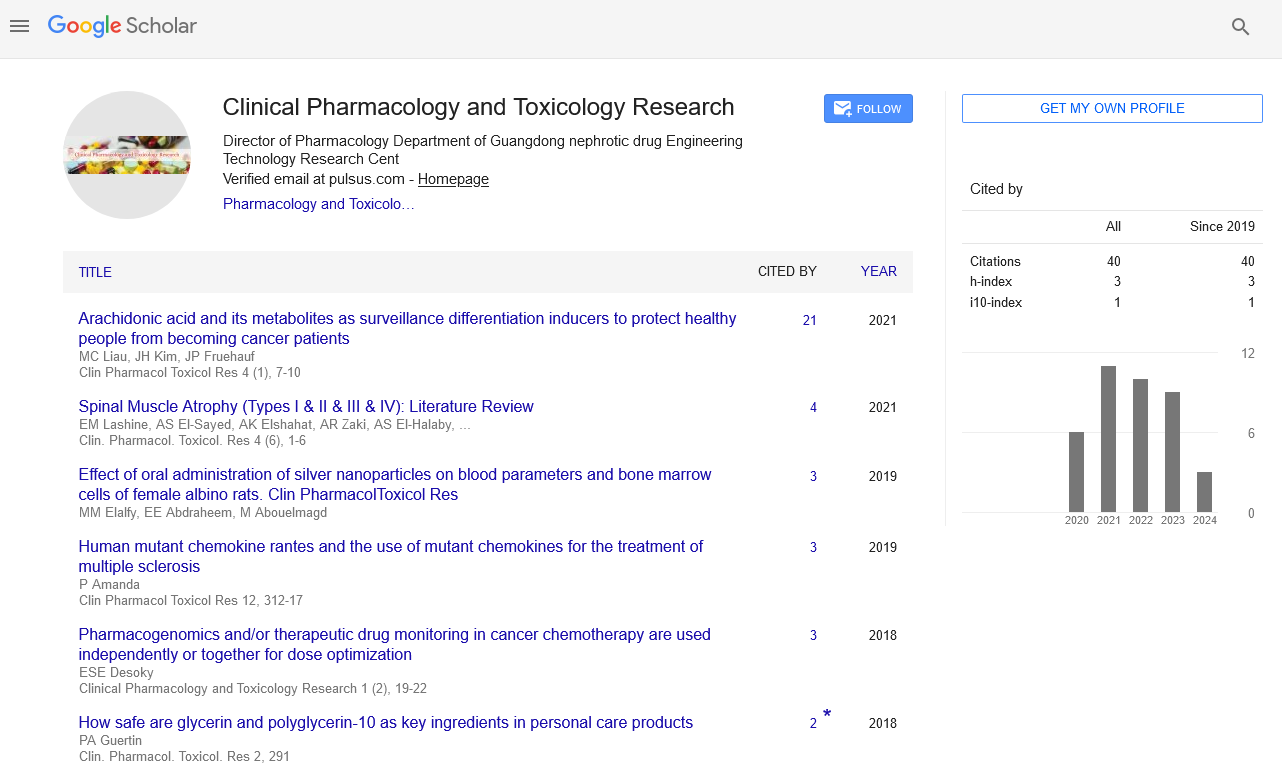Effects of clinical toxicity
Received: 03-May-2021 Accepted Date: May 18, 2021; Published: 25-May-2021
Citation: Berry D. Effects of clinical toxicity. Clin Pharmacol Toxicol Res. 2021;4(3):7.
This open-access article is distributed under the terms of the Creative Commons Attribution Non-Commercial License (CC BY-NC) (http://creativecommons.org/licenses/by-nc/4.0/), which permits reuse, distribution and reproduction of the article, provided that the original work is properly cited and the reuse is restricted to noncommercial purposes. For commercial reuse, contact reprints@pulsus.com
Description
Toxicity is the degree through which a chemical substance or a specific mixture of drugs can damage an organism. Toxicity can ask the effect on an entire organism, like an animal, bacterium, or plant, also because the effect on a substructure of the organism, sort of a cell (cytotoxicity) or an organ just likes the liver (hepatotoxicity). By extension, the word could even be metaphorically used to describe toxic effects on larger and more complex groups, a touch just like the relatives or society at large. Sometimes the word is more or less synonymous with the word poisoning in everyday usage.
A central concept of toxicology is that the results of a toxicant are dose-dependent; even water can cause water intoxication when taken in too high a dose, whereas for even a very toxic substance like venom there is presence of a dose below which there is no detectable toxic effect. Considering the restrictions of this dose-response concept, a totally unique Drug Toxicity Index (DTI) has been proposed recently. DTI redefines the drug toxicity, identifies the presence of hepatotoxic drugs, gives mechanistic insights, predicts clinical outcomes of drugs and has potential as a screening tool. Toxicity is species-specific, making cross-species analysis problematic. Newer paradigms and metrics are evolving to bypass animal testing, while maintaining the concept of toxicity endpoints.
Toxicity
Toxicity is more frequently seen with chronic ingestion of high doses of 30 000–50 000 IU per day. Vitamin A toxicity in children develops following chronic ingestion of 410 times the recommended daily allowance for weeks to months. Malnutrition and individual tolerance also can be factors in predisposition to toxicity. Signs and symptoms of toxicity include vomiting, anorexia, agitation, fatigue, diplopia, headache, bone pain, alopecia, skin lesions, increased intracranial pressure, and papilledema. Hepatic toxicity typically requires months or years of daily high doses of vitamin A. There aren't any known cases of vitamin A toxicity associated with beta-carotene ingestion.
Certain chemicals or substances are often toxic even during a minor or one-time exposure. This is often mentioned as an acute exposure, and each one substance have an acute toxicity. Some substances are often very toxic acutely, even during one exposure. Consider venom. To be efficient for the snake, a very little bit of venom must incapacitate their prey. It might cost them an excessive amount of water and energy to provide large amounts of venom, and it'd even be hard to inject during one dosing.
Ototoxic drugs include antibiotics such as gentamicin, streptomycin, tobramycin, loop diuretics such as furosemide and platinum-based chemotherapy agents such as cisplatin and carboplatin.
A number of Non-Steroidal Anti-Inflammatory Drugs (NSAIDS) have also been shown to be ototoxic. This can result in sensorineural hearing loss, dysequilibrium, or both. Some environmental and occupational chemicals have also been shown to affect the auditory system and interact with noise.
Ototoxicity came to the forefront of clinical attention with the discovery of streptomycin in 1944. Streptomycin was used successfully in the treatment of tuberculosis; however, a substantial number of treated patients were found to develop irreversible cochlear and vestibular dysfunction.
Chronic toxicity is that the opposite of acute toxicity. It’s a measure of how toxic a substance is over a extended period of some time. This might be anything from weeks to years, but it's whilst significant to understand the chronic toxicity of a substance. Many substances we use in consumer products are new science. It’s easy to see their acute toxicity, because it is easy to administer one dose and observe and organism for each week or less. When observing chemicals for signs of being a chronic toxin, the observer must watch the system for the entire lifetime of an organism.





